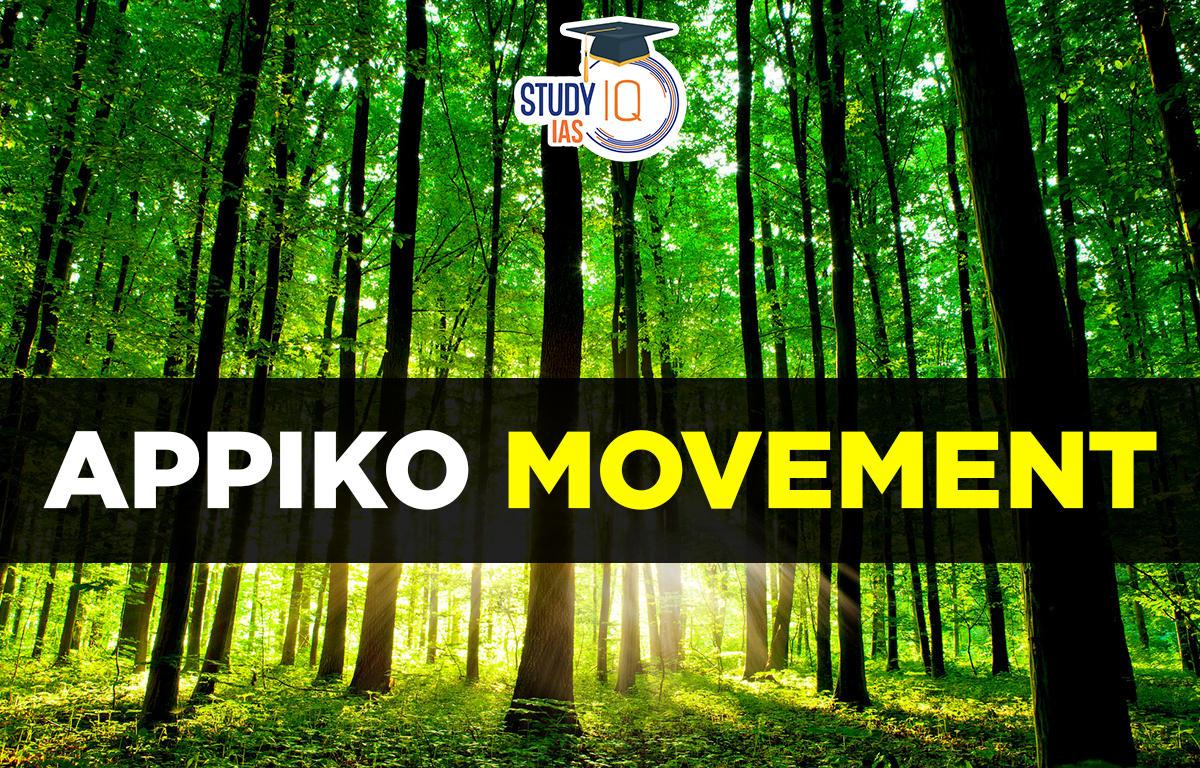Table of Contents
Appiko Movement
One of India’s forest-based environmental initiatives is the Appiko Movement. The Western Ghats region of Karnataka’s Uttara Kanada was the scene of the protest. The movement’s premise is that the forest department had for several decades promoted teak monoculture plantations after removing the original mixed semi-evergreen forests through clear-cutting. It is one of the important topic of Environment one of the important subject of UPSC Syllabus. The UPSC Mock Test can help candidates prepare for the exam with more precision.
Appiko Movement History
The forest cover in the Uttara Kannada district covered more than 81% of its total territory in 1950. The government declared this woodland area to be underdeveloped and began the development process. Three major industries are located in the area: a pulp and paper plant, a plywood factory, and a system of hydroelectric dams built to harness nearby rivers. Large tracts of agricultural and forest territory have been submerged by dams, and these activities have degraded the forest resource.
By 1980, the forest had lost about 25% of its original acreage in the district. The dams uprooted the local population, particularly in the less wealthy areas. Natural mixed woods were turned into teak and eucalyptus plantations, depleting water supplies and harming the forest dwellers.
Appiko Movement Causes
Women and young people in the area made the decision to start a campaign resembling Chipko in South India in September 1983. The name of the organization, Appiko, which in Kannada means “hug,” stands for the protection of the tree. Panduranga Hegde, an environmental activist, established and is the movement’s founder. The campaign aimed to protect the trees in Karnataka’s Kalse forests.
Women and young people travelled five miles to a nearby forest and hugged trees there. They came from Saklani and the neighboring communities. They made the state forest department’s contractors and tree fellers halt their tree-cutting operations. The population requested a prohibition on cutting down green trees. After 38 days of agitation, the state government was eventually compelled to give in to their demands and revoke the tree-cutting order. The Appiko movement, like the Chipko movement, revived Gandhi’s method of protest and mobilization for a sustainable society that balances man and environment.
Appiko Movement Leader
The Appiko Movement led by Paduranga Hedge has great significance.
Appiko Movement Objectives
The preservation of the existing, young, and green forest trees is one of the Appiko Movement’s goals. Promoting afforestation on depleted territory is another goal. Utilizing forest resources while giving careful thought to protecting natural resources was one objective.
To increase comprehension, the Appiko Movement employed a variety of tactics. Slide shows, traditional dances, foot marches through the internal woods, and street plays are a few of these. In a few forest areas, the state government forbade the felling of leafy trees; only deceased, dying, and arid trees were felled to meet local needs.
The Movement encompassed Goa, the Eastern Ghats in Tamil Nadu, and the four hill towns of the Karnataka Province. The Appiko Movement aimed to encourage reforestation of bare areas, or planting more trees. Between 1984 and 1985, the Sirsi region saw the growth of approximately 1.2 million seedlings with the assistance of the forest department. Due to its history of widespread use of chemical fertilisers in forest conservatories, the Appiko Movement has a capital-intensive and profit-driven agenda.
Appiko Movement Result
The Karnataka Appiko Movement allowed the locals to preserve their main supplies of food and water. For making handcrafted items that locals can sell to make a livelihood, trees like bamboo are essential. Additionally, this Movement assisted in saving medicinal trees that the natives could use for their own benefit. Additionally, the Appiko Movement was effective in raising village awareness of the threat posed by falling trees.
This Movement, like other forest-based environmental movements, was effective in getting things done. The Appiko Movement, led by Panduranga Hegde, aimed to raise consciousness about the destruction of traditional livelihoods by clearing and selling off forests. The locals celebrated the trees and employed a variety of other strategies to spread the word about protecting natural forests, including street plays, slide presentations, and folk dances.
Appiko Movement Sustainable Measures
By building (Biogas plants), the Movement discovered a novel method to lighten the burden on the forest. . The main goal of Appiko Andolan advocates is to give money to the less fortunate members of society who cannot afford to buy gobar plants. Few people attempt to recreate the forest region using incorrect cropping techniques.
The Appiko movement aimed to correct someone’s incorrect norms. The Movement seeks to create a proportional relationship between humans and nature. To promote sustainability, protect the substance and keep it around for future generations.
Appiko Movement UPSC
The Paduranga Hedge-led Appiko Movement is extremely important. In September 1983, the Appiko campaign got its start. In Kannada, the language of origin, the term “Appiko” means “hug.” It stands for the tree’s defence. The Chipko Movement and the Appiko Movement were both conservation movements. Students can read all the details related to UPSC visiting the official website of StudyIQ UPSC online Coaching.
























 WhatsApp
WhatsApp